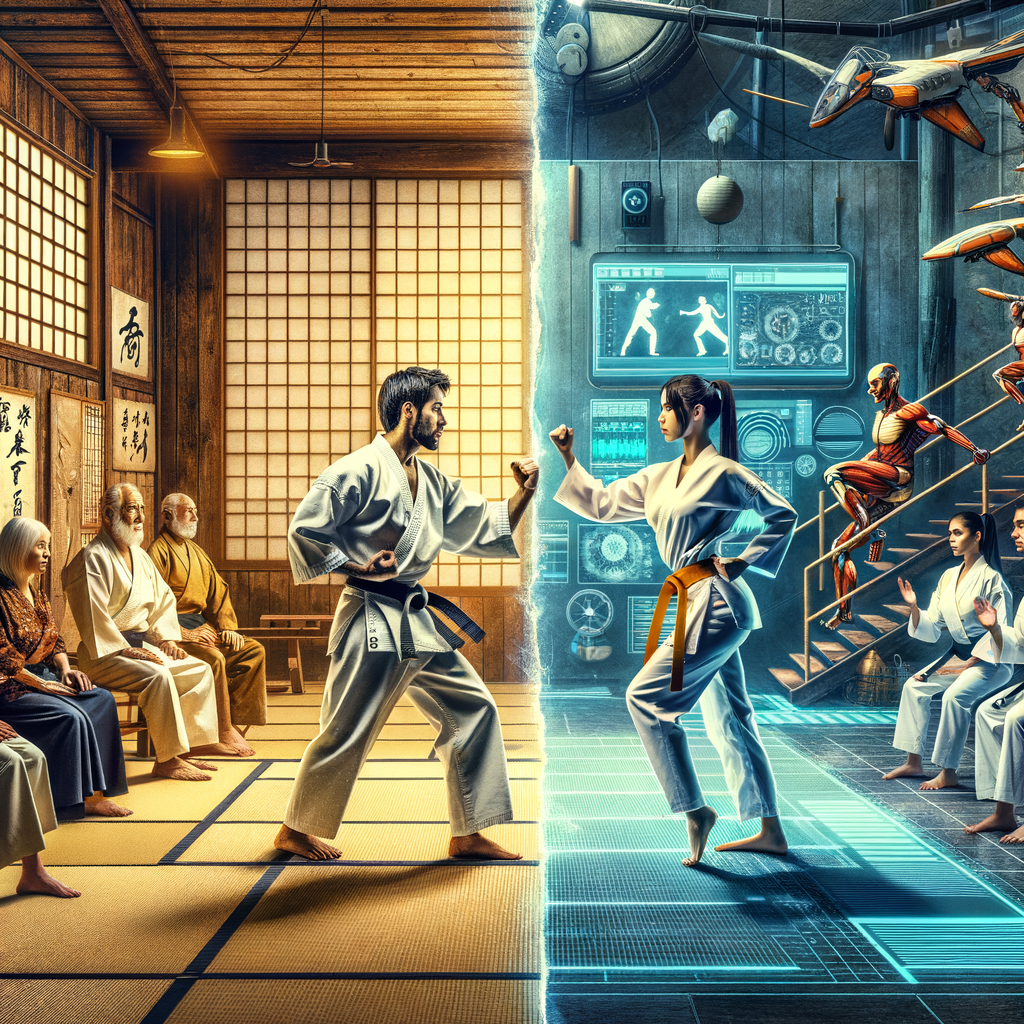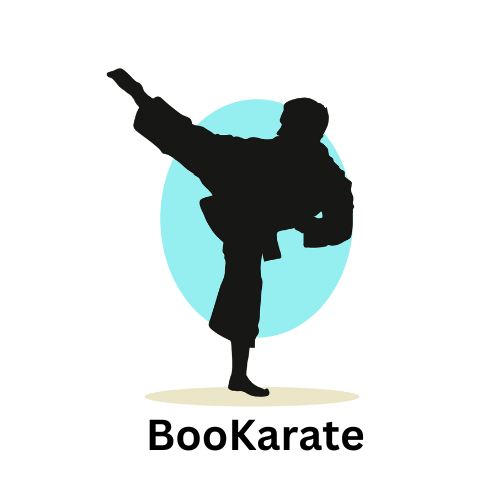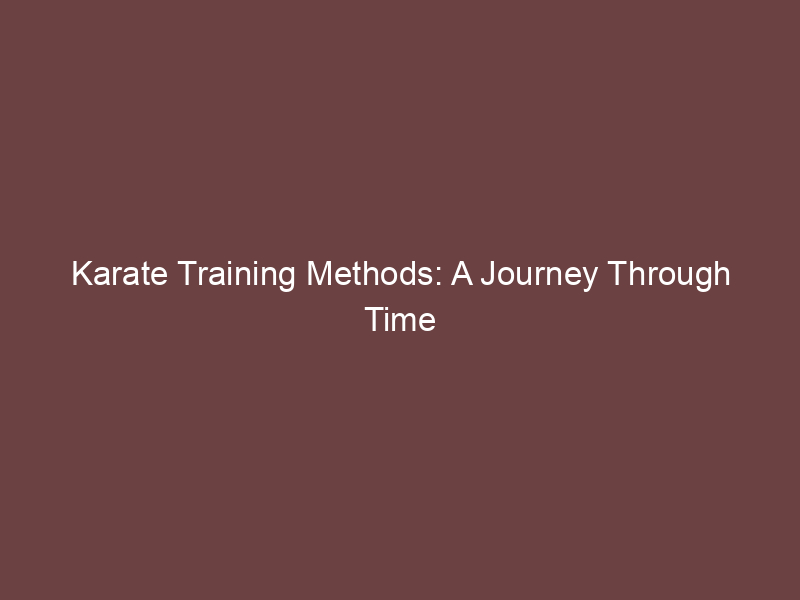
Introduction to Karate Training Methods
Welcome to the world of Karate, a martial art that has been practiced for centuries. In this section, we will delve into the training methods used in Karate, providing an overview of the techniques and highlighting the importance of Karate in the realm of martial arts.
- Overview of Karate Training Techniques
- Importance of Karate in Martial Arts
Karate training techniques are diverse and multifaceted. They range from basic moves like punches and kicks to more complex techniques like grappling and defense against weapons. These techniques are not just about physical strength; they also involve mental focus and discipline. Here’s a brief description of some common Karate training techniques:
| Technique | Description |
|---|---|
| Kihon | This is the foundation of all Karate techniques. It involves basic moves like punches, kicks, knee strikes, and blocks. |
| Kata | This is a sequence of moves that simulate a fight against imaginary opponents. It helps to improve balance, timing, and coordination. |
| Kumite | This is sparring with a real opponent. It helps to improve reaction time and adaptability. |
Karate holds a significant place in the world of martial arts. It’s not just a form of self-defense, but also a way to improve physical fitness, mental strength, and self-discipline. Karate training can help to boost confidence, improve concentration, and promote a sense of respect for others. It’s a holistic approach to personal development that goes beyond the physical realm.
In the following sections, we will delve deeper into the history of Karate, traditional and modern training methods, and how Karate training has evolved over time. Stay tuned to embark on this fascinating journey of Karate training.
History of Karate
Understanding the history of Karate is crucial to appreciate its value and the techniques used in training. Let’s delve into the origins of Karate, the evolution of martial arts, and how history has impacted Karate training methods.
- Origins of Karate
- Evolution of martial arts
- Impact of history on Karate training methods
Karate, which means “empty hand”, originated in the Ryukyu Kingdom, now known as Okinawa, Japan, in the early 17th century. It was a time when weapons were banned by the ruling class, leading the locals to develop a form of self-defense using their bodies. The art form was initially known as “Te” or “hand”.
Over the centuries, martial arts have evolved significantly. In the 19th century, “Te” was further developed and renamed “Karate” by Anko Itosu, a master who introduced the art to Okinawa’s school system. Itosu’s student, Gichin Funakoshi, brought Karate to mainland Japan in the 1920s, where it gained popularity and was incorporated into Japan’s physical education programs.
The history of Karate has greatly influenced its training methods. In the early days, training was focused on strengthening the body for hard labor and protecting oneself without weapons. As Karate evolved, training methods became more refined, focusing on discipline, character development, and physical fitness. Today, Karate training includes a combination of traditional techniques and modern fitness principles.
In conclusion, the history of Karate is a testament to the resilience and creativity of the human spirit. From its humble beginnings as a form of self-defense in a weaponless society, it has evolved into a respected martial art practiced worldwide for its physical and mental benefits.
| Period | Key Developments |
|---|---|
| 17th Century | Origination of Karate in Ryukyu Kingdom |
| 19th Century | Renaming and development of “Te” into “Karate” by Anko Itosu |
| 1920s | Introduction of Karate to mainland Japan by Gichin Funakoshi |
| Present Day | Global recognition and practice of Karate |
Traditional Karate Training
In this section, we delve into the world of traditional karate training. We’ll explore what traditional karate entails and highlight some key training techniques.
Understanding Traditional Karate
Traditional karate is a martial art that originated in Okinawa, Japan. It emphasizes self-development, discipline, and respect. Let’s break down the definition and principles of traditional karate, as well as some key training techniques.
- Definition and principles
- Key traditional Karate training techniques
- Kihon: This is the practice of basic techniques such as punching, kicking, blocking, and striking.
- Kata: Kata are pre-arranged sequences of movements that simulate combat scenarios. They are a way to practice techniques in a structured manner.
- Kumite: This is the practice of sparring with a partner. It helps students apply the techniques they’ve learned in a controlled environment.
Traditional karate is a system of self-defense that involves a combination of strikes, kicks, and defensive moves. It’s not just about physical strength; it’s also about mental and spiritual discipline. The principles of traditional karate include respect, integrity, perseverance, and self-control.
There are several techniques in traditional karate training. Here are a few:
Understanding traditional karate and its training techniques is crucial for anyone interested in this martial art. It offers a holistic approach to self-defense, focusing not just on physical strength, but also on mental and spiritual discipline.
Benefits and Limitations of Traditional Karate
- Benefits of traditional training methods
- Limitations and challenges
Traditional karate training methods have a number of benefits. First and foremost, they provide a strong foundation in the basic principles of karate. These methods focus on form, technique, and discipline, which are essential for mastering the art of karate. Traditional training also emphasizes the importance of respect and humility, values that are integral to the martial arts ethos.
Another benefit of traditional karate training is that it offers a comprehensive workout. It engages the entire body, improving strength, flexibility, balance, and coordination. Moreover, traditional karate training also provides mental benefits. It promotes focus, concentration, and self-discipline, which can be beneficial in all areas of life.
Lastly, traditional karate training is steeped in history and culture. It offers a unique opportunity to learn about and connect with the rich heritage of the martial arts.
Despite its many benefits, traditional karate training also has its limitations and challenges. One of the main challenges is that it can be quite rigorous and demanding. The focus on form and technique means that it requires a high level of discipline and commitment. This can be challenging for beginners or for those who are not used to such intense training.
Another limitation of traditional karate training is that it may not be as appealing to those who are looking for a more modern, dynamic workout. While traditional training provides a comprehensive workout, it does not incorporate the high-intensity, fast-paced elements that are often found in modern fitness regimes.
Finally, traditional karate training may not be suitable for everyone. It requires a certain level of physical fitness and flexibility, which may not be achievable for individuals with certain health conditions or physical limitations.
Modern Karate Training
In this section, we will delve into the world of modern Karate training. We will explore its unique characteristics, techniques, and how it differs from traditional methods.
Exploring Modern Karate
Modern Karate training is a fascinating blend of traditional techniques and new-age fitness principles. It aims to provide a comprehensive workout while still maintaining the essence of Karate.
- Introduction to modern Karate training
- Key modern Karate training techniques
Modern Karate training is a dynamic and evolving practice. It incorporates elements of traditional Karate, such as kata (formal exercises) and kumite (sparring), with modern fitness techniques. This approach ensures that practitioners not only learn the art of Karate but also improve their overall physical fitness. Modern Karate training focuses on flexibility, strength, endurance, and agility, making it a holistic fitness regimen.
There are several key techniques in modern Karate training. These include:
| Technique | Description |
|---|---|
| Kata | A series of movements and techniques that are performed in a pattern. Modern Karate training often includes variations of traditional kata to enhance physical fitness. |
| Kumite | Sparring with a partner. In modern Karate training, kumite often involves controlled contact to ensure safety while still providing a realistic training experience. |
| Strength and Conditioning | Modern Karate training incorporates strength and conditioning exercises to improve physical fitness and performance. These exercises can include weightlifting, plyometrics, and high-intensity interval training (HIIT). |
Modern Karate training is an exciting and dynamic way to learn Karate. It provides a comprehensive workout, improves physical fitness, and teaches valuable self-defense skills. Whether you’re a beginner or a seasoned martial artist, modern Karate training offers a unique and rewarding experience.
Benefits and Limitations of Modern Karate
Modern karate training has transformed the way practitioners learn and master this ancient martial art. However, like any other method, it comes with its unique set of benefits and limitations. Let’s delve into these aspects for a better understanding.
- Advantages of Modern Training Methods
- Accessibility: Modern training methods often incorporate online resources and virtual classes. This makes learning karate more accessible to people who may not have a dojo nearby.
- Efficiency: Modern training techniques often focus on the most effective moves and strategies, allowing students to learn practical skills in a shorter amount of time.
- Adaptability: Modern training methods can be tailored to the individual’s fitness level and learning pace, making karate more inclusive and adaptable.
- Challenges and Criticisms
- Loss of Tradition: Some critics argue that modern training methods risk losing the traditional essence of karate. They believe that the focus on efficiency and practicality may lead to the neglect of important cultural and philosophical aspects of the martial art.
- Quality of Instruction: With the rise of online classes, there are concerns about the quality of instruction. Without the direct supervision of a skilled sensei, students may develop incorrect techniques or miss out on important feedback.
- Overemphasis on Competition: Some believe that modern training methods place too much emphasis on competition and winning, rather than on self-improvement and discipline.
Modern karate training methods offer numerous advantages. They are designed to be more accessible, efficient, and adaptable to the individual’s needs. Here are some of the key benefits:
Despite these advantages, modern karate training methods are not without their challenges and criticisms. Here are some of the common issues raised:
In conclusion, modern karate training methods offer numerous benefits, including accessibility, efficiency, and adaptability. However, they also face criticisms, including potential loss of tradition, concerns about the quality of instruction, and an overemphasis on competition. As with any method, it’s important for each practitioner to find a balance that works best for them.
Karate Training Methods Comparison
When it comes to Karate training, there are two main methods that are often discussed: traditional and modern. Both have their own unique strengths and weaknesses, and understanding these can help you decide which method is right for you.
- Comparing traditional and modern Karate training
- Impact of evolution on Karate
Traditional Karate training is often characterized by its focus on discipline, respect, and the mastering of basic techniques. It is often taught in a formal setting, with a strong emphasis on the history and philosophy of Karate. On the other hand, modern Karate training tends to be more dynamic and flexible. It often incorporates elements from other martial arts and focuses on practical self-defense techniques.
While traditional training can provide a deep understanding and appreciation of Karate, it may not be as appealing to those looking for a more diverse and adaptable training method. Conversely, while modern training can offer a more varied and exciting experience, it may lack the depth and discipline of traditional training.
Over the years, Karate has evolved significantly. The traditional methods of training have been adapted to suit the needs of modern practitioners. This has led to the development of new techniques and training methods.
However, despite these changes, the core principles of Karate remain the same. Respect, discipline, and the pursuit of self-improvement are still at the heart of Karate, regardless of the training method used.
In conclusion, both traditional and modern Karate training methods have their own merits. The best method for you will depend on your personal goals and preferences. Whether you choose traditional or modern training, the most important thing is to train with dedication and respect for the art of Karate.
Changes in Karate Training Over Time
Over the years, Karate training has undergone significant changes. These changes have been influenced by various factors including technological advancements, changes in societal norms, and the evolution of martial arts as a whole. Let’s delve into the key developments and future trends in Karate training.
- Key Developments in Karate Training
- Future Trends in Karate Training
Historically, Karate training was primarily focused on self-defense. The training was rigorous, with a strong emphasis on discipline and respect. However, over time, the focus has shifted to include a more holistic approach to physical fitness and mental well-being.
One of the significant developments in Karate training is the introduction of protective gear. In the past, Karate students trained without any protective gear, which often led to injuries. Today, students wear protective gear such as headgear, mouth guards, and chest protectors to minimize the risk of injury.
Another key development is the use of technology in Karate training. Today, many Karate schools use video analysis software to help students improve their techniques. This software allows students and instructors to analyze movements frame by frame, making it easier to identify and correct mistakes.
Looking ahead, we can expect to see even more changes in Karate training. One of the potential trends is the increased use of virtual reality (VR) technology. VR could provide a more immersive training experience, allowing students to practice in a variety of scenarios and environments.
Another future trend could be the integration of artificial intelligence (AI) into Karate training. AI could be used to analyze students’ movements and provide personalized feedback, helping them to improve faster.
Lastly, we might see a greater emphasis on mental training in Karate. As our understanding of the mind-body connection continues to grow, Karate instructors may start incorporating more mental exercises into their training programs, such as meditation and mindfulness practices.
In conclusion, Karate training has come a long way from its traditional roots. As we move into the future, we can expect to see even more exciting developments in this dynamic martial art.
Conclusion: The Journey of Karate Training
In this article, we have embarked on an enlightening journey, tracing the roots and evolution of Karate training. We’ve seen how it has grown, adapted, and transformed over the centuries to become the respected martial art it is today.
- Recap of Karate Training Evolution
- Final Thoughts on the Journey of Karate Training
Our journey began with an exploration of the history of Karate, where we learned about its origins in Okinawa and its spread to mainland Japan and the rest of the world. We then delved into the traditional Karate training methods, which emphasized discipline, respect, and the mastering of basic techniques.
As we moved forward in time, we discovered the emergence of modern Karate training, which incorporates technology and scientific understanding of the human body to enhance training efficiency. We also compared these two training methods, highlighting their unique strengths and how they contribute to the overall effectiveness of Karate training.
Finally, we examined the changes in Karate training over time, observing how it has evolved to meet the needs of different generations while maintaining its core principles and values.
Reflecting on this journey, it is clear that Karate training is more than just a physical activity. It is a discipline that fosters mental strength, self-control, and respect for others. Its evolution over time demonstrates its adaptability and relevance in today’s world.
Whether you are a beginner or an experienced practitioner, understanding the journey of Karate training can deepen your appreciation for this martial art and inspire you to continue honing your skills. As the famous Karate master Gichin Funakoshi once said, “Karate is like boiling water; if you do not heat it constantly, it will cool.”






